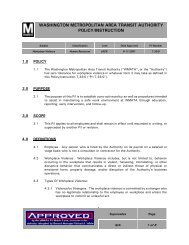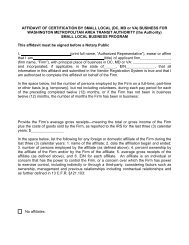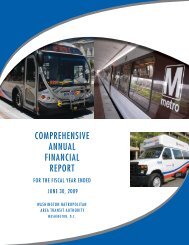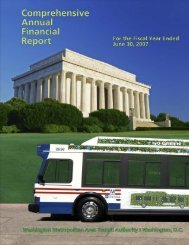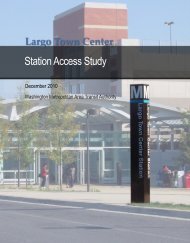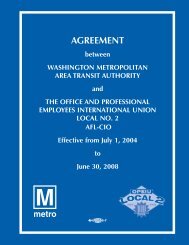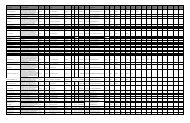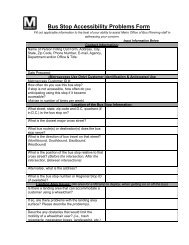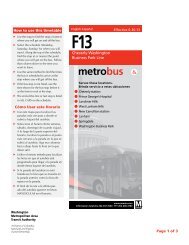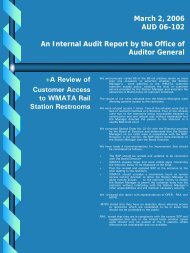feasibility study of real time parking information at ... - WMATA.com
feasibility study of real time parking information at ... - WMATA.com
feasibility study of real time parking information at ... - WMATA.com
Create successful ePaper yourself
Turn your PDF publications into a flip-book with our unique Google optimized e-Paper software.
<strong>WMATA</strong> Real-Time Parking<br />
Inform<strong>at</strong>ion Feasibility Study<br />
Chapter 3: BEST PRACTICES REVIEW<br />
• The field test did not employ enough PDAs for every enforcement <strong>of</strong>ficer and as<br />
a result <strong>of</strong> staff rot<strong>at</strong>ions it was not possible to consistently implement this<br />
method <strong>of</strong> enforcement during the research project. Increased investment in<br />
enforcement technology would be preferable.<br />
• Since free <strong>parking</strong> was <strong>of</strong>fered <strong>at</strong> the Rockridge BART st<strong>at</strong>ion <strong>at</strong> 10 AM, this<br />
made it difficult to determine if an unreserved vehicle had parked legally (after 10<br />
AM) using the faxed list <strong>of</strong> confirmed reserv<strong>at</strong>ions alone. One <strong>of</strong>ficer used chalk<br />
to mark tires <strong>at</strong> 9:30 AM and issued a ticket if the vehicle did not have a<br />
reserv<strong>at</strong>ion by 10:05 AM. It was helpful to have a live oper<strong>at</strong>or available to assist<br />
users when <strong>parking</strong> tickets were issued in error.<br />
• It was noted th<strong>at</strong> there was neither an easily accessible phone nor kiosk near the<br />
smart <strong>parking</strong> lot, making it difficult for users without mobile phones to make<br />
drive-in reserv<strong>at</strong>ions. It was suggested th<strong>at</strong> a courtesy phone be placed closer to<br />
the smart <strong>parking</strong> area to make it more convenient for users without mobile<br />
phones.<br />
• It is helpful to have a live oper<strong>at</strong>or on the phone system to answer questions, etc.<br />
It was also some<strong>time</strong>s difficult for the autom<strong>at</strong>ed phone system to identify users’<br />
accents further requiring the need <strong>of</strong> a live oper<strong>at</strong>or.<br />
• Adding options to the phone reserv<strong>at</strong>ion system such as “repe<strong>at</strong>,” <strong>inform<strong>at</strong>ion</strong><br />
confirm<strong>at</strong>ions, and the ability to skip through beginning instructions would be<br />
beneficial.<br />
• Charging <strong>parking</strong> reserv<strong>at</strong>ion fees on a per-transaction basis was preferable to<br />
users carrying a balance on their accounts.<br />
• The most difficulty arose from the in-ground sensors. Prior to this project, the<br />
sensors had been used on highways and streets with traffic in one direction only.<br />
Project partners modified the firmware to detect two-way vehicle movements,<br />
and testing <strong>at</strong> an <strong>of</strong>f-site loc<strong>at</strong>ion indic<strong>at</strong>ed th<strong>at</strong> they worked well. At the BART<br />
st<strong>at</strong>ion, the sensors were unable to accur<strong>at</strong>ely count vehicles moving <strong>at</strong> <strong>parking</strong><br />
lot speeds. Project partners noted th<strong>at</strong> this problem may have resulted from the<br />
magnetic field <strong>at</strong> the BART st<strong>at</strong>ion, since the sensors perform by detecting the<br />
changing magnetic fields from vehicles passing over the sensors. Also, sensors<br />
had difficulty accounting for <strong>at</strong>ypical vehicle movements, such as cars driving into<br />
or out <strong>of</strong> the lot the wrong way. The sensors were eventually replaced during the<br />
field test with ones th<strong>at</strong> were situ<strong>at</strong>ed aboveground, which were more effective<br />
and less expensive. The integr<strong>at</strong>ion <strong>of</strong> the new sensors with the wireless<br />
counting system resulted in <strong>com</strong>munic<strong>at</strong>ion protocol problems th<strong>at</strong> were resolved<br />
by technicians. Researchers ultim<strong>at</strong>ely maintained count accuracy by using a<br />
proprietary algorithm th<strong>at</strong> corrected the sensor problems and accounted for<br />
instances when vehicles queued above the sensors.<br />
Results - At the conclusion <strong>of</strong> the field test in 2006, the project ac<strong>com</strong>mod<strong>at</strong>ed more<br />
than 13,000 successful <strong>parking</strong> occurrences by 1,245 users. More than 4,000 smart<br />
<strong>parking</strong> reserv<strong>at</strong>ions were made through the online reserv<strong>at</strong>ion system. Space<br />
utiliz<strong>at</strong>ion increased from five to 75 percent (i.e., 38 <strong>of</strong> 50 spaces filled) during the first<br />
three months <strong>of</strong> oper<strong>at</strong>ion and was sustained <strong>at</strong> th<strong>at</strong> level for the remainder <strong>of</strong> the<br />
project. The smart <strong>parking</strong> field test helped to manage <strong>parking</strong> capacity without a new<br />
capital expenditure for construction.<br />
Travel behaviors affecting the smart <strong>parking</strong> field test were evalu<strong>at</strong>ed by administering<br />
before and after Internet-based user surveys. More than 30 percent <strong>of</strong> respondents<br />
Page 3-11 June 2009





